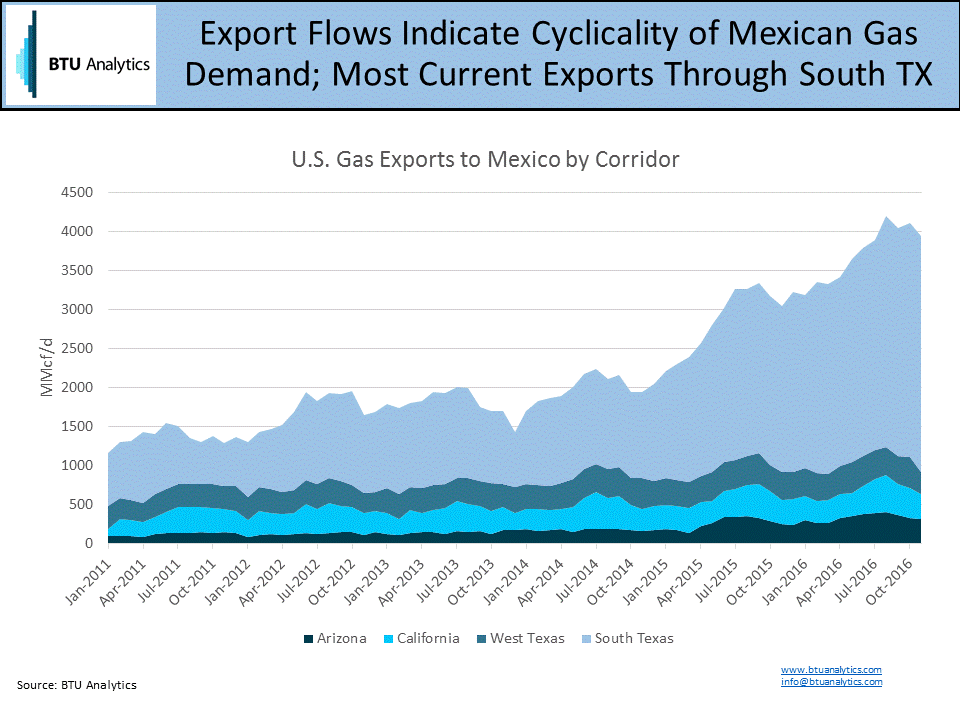Mexican natural gas exports continue to set up for growth in 2017 and beyond as a wave of new pipelines and power plant projects come to market. By the end of 2017, twelve new natural gas pipelines are expected to be placed in service, facilitating natural gas export growth and providing increased interconnectivity for the Mexican natural gas grid. In addition to the natural gas pipeline projects, power plant operators are expected to install 1,990 MW of new combined cycle natural gas power plants providing incremental natural gas demand for the new and existing Mexican natural gas export infrastructure.
In West Texas, ETP’s Trans – Pecos and Comanche Trail projects and ONEOK’s Roadrunner Phase II are scheduled to begin transporting gas from the Waha Hub to El Paso export crossings. Combined, these projects are expected to add 2.9 Bcf/d of capacity from the Permian to Mexico. Despite some push back on the Pecos pipeline regarding construction in the Big Bend region, all three projects have moved forward as scheduled, receiving their international crossings authorizations from FERC without delay.

On the other side of the border, IEnova’s new San Isidro – Samalyuca and Ojinaga – El Encino pipelines are slated to link with Comanche Trail and Trans-Pecos by the end of Q1, while Roadrunner will supply the operational Tarahumara line running to El Encino. The El Encino to La Laguna is also expected to be online in Q1 to supply plants in Chihuahua and in the Central and Western regions of the county.
In the second half of the year, three more pipes are expected to connect West Texas exports with West Coast gas plants expected for completion in the coming years. Samalyuca-Sasabe will link 0.5 Bcf/d of capacity with the new Guyamas-El Oro line on the West Coast while the line from El Encino to Topolobampo will add 0.7 Bcf/d to plants further south along the coast.
South Texas is also expected to get 1.2 Bcf/d of natural gas export capacity expansions by the end of this year, with Howard Energy Partners’ Nueva Era slated to add 504 MMcf/d by June and Kinder Morgan’s Mier – Monterrey expansion adding 700 MMcf/d by December to its current 640 MMcf/d system.

Assuming all goes according to schedule, U.S. gas export capacity to Mexico could increase 4 Bcf/d by the end of 2017 while domestic capacity in Mexico would increase by 5.8 Bcf/d. A banner year for Mexican gas export capacity and the associated downstream pipeline infrastructure for sure.
Supporting the pipeline build out in 2017, two new natural gas-fired power plants are slated to come online in 2017 adding a combined 1,697 MW of generating capacity. Assuming 75% plant utilization and a plant efficiency of 6.8 Btu/kWh, Guayamas II at Enpalme on the West Coast is expected to add 94 MMcf/d of natural gas demand by July while Norte III near Ciudad Juárez is expected to add 111 MMcf/d by November.
The expansions planned for the Mexican pipeline grid are intended to provide a long-term foundation for increased natural gas burn, meaning exports are more likely to gradually increase as projects are completed. CFE’s current docket of gas-fired new builds and conversions extends to 2028 and the agency predicts that regional rates of electricity demand growth will range from 3.6% to 4.8%.
Northern Mexico has little natural gas storage and EIA’s data on Mexican gas exports highlights that natural gas demand is also seasonal. For this reason, excess pipeline capacity for summer natural gas demand for electrical generation is necessary.

While our outlook for West Texas gas exports is slightly positive, timing is always critical with infrastructure projects. Guaymas II won’t be linked to Texas export crossings until Samalyuca-Sasabe’s expected in-service date at the end of the year.
It also remains to be seen whether all of the projects slated for completion this year will meet their current in service dates. Several gas plant projects in Mexico have been delayed since CFE’s previous plan was released in 2014. Operation at Guyamas II was previously planned for April while Guayamas III (90 MMcf/d) and Norte III have been pushed back from July service to November 2017 and April 2018, respectively.
Delays have also dimmed the outlook for South Texas exports this year. The Noreste plant in Escobedo, Nuevo Leon was previously slated to add 126 MMcf/d in December but has been pushed back to July 2018 with a lower generation capacity, resulting in expected demand dropping to 105 MMcf/d.
Altogether, demand for Texas natural gas exports for natural gas power burn in Mexico is expected to increase by 205 MMcf/d this year. In addition to natural gas demand from power plants, Mexican natural gas production continues to decline as we highlighted in Henry Hub Prices Set to Rise. New pipeline infrastructure facilitating increased access to Permian and Eagle Ford supply could also be a boon for industrial demand in Mexico though quantifying increases due to specific projects remains a challenge. Even with declining Mexican production, power demand alone will not be enough to fill all of these export routes to Mexico. For more on BTU Analytics’ outlook on natural gas market dynamics and exports to Mexico, see our Henry Hub Outlook.









